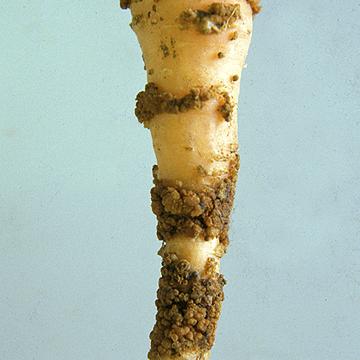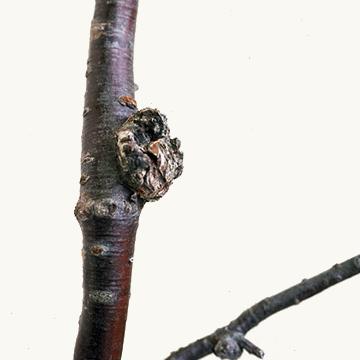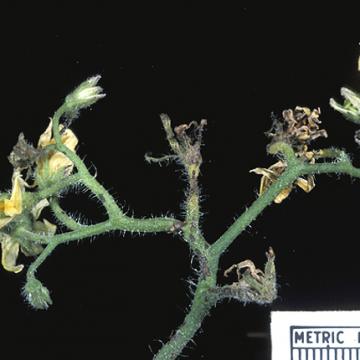DISEASE: Bacterial gall
HOST: Carrot
Root with many galls of different sizes.

Bacterial gall | Carrot
DISEASE: Bacterial gall
HOST: Carrot (Daucus carota)
PATHOGEN: Rhizobacter dauci
SOURCE: H. Kuwata
DISEASE: Bacterial gall
HOST: Carrot
Galls caused from inoculation of injured roots (left two) and uninjured roots (center two). Uninjured, noninoculated root (right).

Bacterial gall | Carrot
DISEASE: Bacterial gall
HOST: Carrot (Daucus carota)
PATHOGEN: Rhizobacter dauci
SOURCE: M. Goto
DISEASE: Bacterial gall
HOST: Cherry
Small gall on twig.

Bacterial gall | Cherry
DISEASE: Bacterial gall
HOST: Cherry (Prunus avium)
PATHOGEN: Pseudomonas syringae pv. cerasicola
SOURCE: H. Kamiunten, M. Goto
DISEASE: Bacterial gall
HOST: Wisteria (Japanese wisteria)
Multiple galls on trunk.

Bacterial gall | Wisteria (Japanese wisteria)
DISEASE: Bacterial gall
HOST: Wisteria (Japanese wisteria) (Wisteria floribunda)
PATHOGEN: Pantoea agglomerans pv. millettiae
PATHOGEN SYNONYM: Erwinia herbicola pv. millettiae
SOURCE: M. Goto
DISEASE: Bacterial gall
HOST: Wisteria (Japanese wisteria)
Gall on branch.

Bacterial gall | Wisteria (Japanese wisteria)
DISEASE: Bacterial gall
HOST: Wisteria (Japanese wisteria) (Wisteria floribunda)
PATHOGEN: Pantoea agglomerans pv. millettiae
PATHOGEN SYNONYM: Erwinia herbicola pv. millettiae
SOURCE: M. Goto
DISEASE: Bacterial speck
HOST: Tomato
Leaf with typical brown to black lesions without halos, an early stage of disease.

Bacterial speck | Tomato
DISEASE: Bacterial speck
HOST: Tomato (Lycopersicon esculentum)
PATHOGEN: Pseudomonas syringae pv. tomato
SOURCE: S. Thomson
DISEASE: Bacterial speck
HOST: Tomato
Leaves with spots, some surrounded by chlorotic zones.

Bacterial speck | Tomato
DISEASE: Bacterial speck
HOST: Tomato (Lycopersicon esculentum)
PATHOGEN: Pseudomonas syringae pv. tomato
SOURCE: R. Gitaitis
DISEASE: Bacterial speck
HOST: Tomato
Curling leaves with large, blackish lesions. Later, yellowing occurs around lesions.

Bacterial speck | Tomato
DISEASE: Bacterial speck
HOST: Tomato (Lycopersicon esculentum)
PATHOGEN: Pseudomonas syringae pv. tomato
SOURCE: M. Schroth











